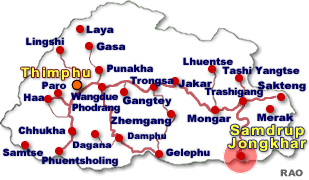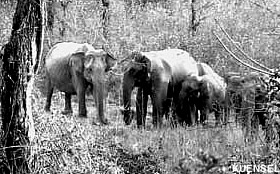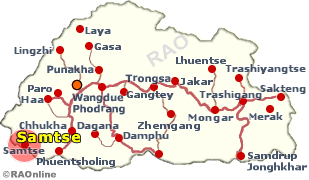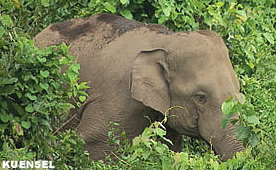| Bhutan's
Nature - Animals |
 |
Bhutan Nature Animals |
 |
Bhutan Information |
|
|
 |
| Wild elephants in Southern Bhutan |
| Samdrup Jongkhar - Tuskers attack traffic |
 |
 |
|
Elephants are a menace not just to people living in southern dzongkhags, but also to those travelling by road between Nganglam and Samdrup Jongkhar along the south-eastern border.
The journey requires plying through the border area of Rangapani in the Indian state of Assam, which is forested and elephant territory.
|
|
In the most recent case on 20 September 2011, a lone passenger of a Toyota Hilux narrowly escaped being attacked by a rogue elephant at Digandari, about 2km from Rinchenthang checkpost in Nganglam.
According to the vehicle owner, Sonam Gyaenzin, 58, when he saw the elephant charging towards him he quickly went into reverse gear and backed his Hilux about 200m. "My vehicle got stuck in a drain and I got out and ran for about another 300m," the former civil servant said.
Sonam Gyaenzin managed to resume his journey, after seeking help from the border forest officials, who chased away the elephant.
"It was the size of a truck and it covered the whole road," he said.
 |
| Wild elephants have become a nuisance to farmers in South Bhutan |
|
Last month, the Nganglam police Hilux travelling to Samdrup Jongkhar with a prisoner was hit by a mother elephant, which had two calves, damaging the bonnet and the windshield. There were five people in the vehicle, four police escorts and the prisoner.
Police sources said they encountered the elephants at a sharp turning.
|
|
Although there is no record on elephant attacks, Nganglam residents say that about 20 people from across the border were killed by elephants in the area this year alone.
Nganglam dungpa, Nima Gyeltshen, said the journey has become risky, especially at night. "He said that elephant attacks are more in the area, as the road passes through the Royal Manas National Park," he said.
 |
| Contributed by Tshering Namgyal, KUENSEL, Bhutan's national newspaper, 2011 |
top
|
Chhukha - The resident elephants of Gedu
|
 |
 |
| Fragmentation of wildlife habitat from rapid industrialisation and development activities in southern Bhutan have disturbed traditional migratory routes and led to the confinement of seven elephants in the forests of Gedu in Chhukha, says a document on the elephant project.
Forest officials, however, call this herd as "resident population," because no study has been done so far to find out if the herd is "confined."
|
|
Monitoring of these elephants by Gedu forest division officials began only from 1995. "We don't know for how long these elephants have been living here," said the chief forestry officer at Gedu, Sonam Tshering. He said that the area of the elephants' habitat has also not been mapped and measured.
The document however states that the herd could have been probably separated from the main herds in late 80s and "confined" within the broadleaf forest in Gedu.
Sonam Tshering said that, without a study to base on, it is not known if developmental activities, such as the growth of Pasakha industries and the construction of roads, especially the Pasakha-Manitar road, could have disturbed the elephants' normal traditional migratory routes.
Also, there are two limestone mines outside the elephant's habitat, one has not begun its operation, although forest officials learnt that it's already approved.
The one in operation, say forest officials, existed even before the elephant project began in 2004. "We can't ask them to close down their work and so we request them to use noiseless explosives," said the division's ranger, M N Basnet.
But locals, especially the elderly, say that there used to be lots of elephants in Gedu, before roads and other developments came up.
 |
| Wild elephants have become a nuisance to farmers in South Bhutan |
|
Ap Thinley, 55, who has been living in Gedu for the last 24 years, said that the area, where the town has come up, was initially where the elephants lived. "There was just a lone plywood factory in the middle of the forest, which also was the elephant's home," he said. "But, as roads came up and forest cover and food for them decreased, they moved further down into the forest. Elephants like to live in places where there are no disturbances."
|
|
Sixty-year-old Dorji Wangchuk from Tashigang village in Gedu added that, with the mushrooming of human settlements, they don't even see elephant footprints today. "They've all moved," he said.
Judor Rinzin, 58, who has lived all his life in Gedu, said that they used to see elephants about 20 years ago. "But, with the project, roads and people, they stopped coming at all," he said. "Cow herders say that they are in the jungles of Tasha, above Pasakha. They can't go down because of the industries in Pasakha nor come up."
About 40 years ago, a white elephant, said village elders used to visit the Gedu goemba, which is about six kilometres below Gedu town. "We don't know its significance, but it used to come once every year and its footprints were as huge as a bamboo basket's rim," said Judor. "But it stopped coming after a few years."
Forest officials, however, said that nothing would stop these elephants from migrating. "If they want to, they'll move anytime they want to," said Sonam Tshering. "There's protection and enough food for them to feed on here and that could be one of the reasons for them living here."
In 2004-2005, the World Wildlife Fund (WWF), which supports the conservation of Asiatic elephant in Bhutan project, helped in the habitat enrichment of these seven elephants through plantation of fodder, construction of water holes and supply of salts.
About 1,500 sq km of area along the southern borders, from Dhansirichu in the east to Sipsu, Samtse, in the west, along the Indo-Bhutan border, is home to Bhutan's elephants.
"So far no damage to crops or humans by these elephants has been reported in Gedu," said Sonam Tshering. "And the fact that they're living in this forest could also mean that they're not disturbed by any of the activities."
 |
| Contributed by Sonam Pelden, KUENSEL, Bhutan's national newspaper, 2010 |
top
| Wildlife and People in Bhutan |
 |
| Information on Bhutan |
 |
| Links |
 |
|






